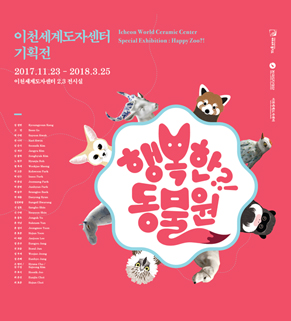

- Duration : November 23 (Thursday), 2017 ~ March 25 (Sunday), 2018
- Place : Gallery 2 & 3, World Ceramic Center
- Capacity : 110 works by 30 artists
Featuring 110 works about familiar animals by 30 artists, the exhibition is an opportunity for visitors to appreciate the diverse expressive styles of contemporary ceramics, think about the dignity of life, and ponder the coexistence of humans and animals.
Can animals that have lived together with humans for a long time be happy?
The special exhibition Happy Zoo?! sheds light on sociocultural stories involving animals through ceramic artworks.
One of the high profile social issues today involves animals kept as pets. They make humans feel more secure and comfortable. The number of pets nationwide is now around 10 million, and some ninety thousand are abandoned every year. Countless domesticated animals are raised in terrible conditions as food for humans. What is more, millions of animals are used in experiments to improve and advance human health, and species of animals are endangered or pushed into extinction due to indiscreet land development.
What should we do for these animals?
This exhibition reflects on our perception of nature as something to be conquered and utilized, and then urges us to consider living creatures as important and to respect life.
It is presented in two sections. Section 1 features animals of various shapes that impart warm feelings.
Section 2 displays works that inspire us to find ways for animals and humans to be happy together in harmony. We hope that the visitors appreciate the diverse works about animals, think about the dignity of life once again, and then ponder coexistence of humans and animals.
Section 1: Welcoming New Family Members
Section 2: Dreaming of a World Where We Are Happier Together
Participating Artist
- Kyoungyoun Kang

- Introduction
Kyoungyoun Kang is deeply interested in communion between humans and animals.
The artist has come to know cats very well by closely observing and communing with them. Cats are tamed by humans, but they still prefer to lead solitary lives without losing their nature.
Such ambivalent attributes of cats can be projected into the reality of women. While living as a woman within the norms determined by society, sometimes adapting and sometimes resisting, the desire to be oneself never withers.
The cat and the bird in Kang’s works are references to desire and insistence for freedom and independence. Kang’s works well express the sense of kinship between women and animals, which is only possible because the artist understands animals as living creatures that are equal to humans.
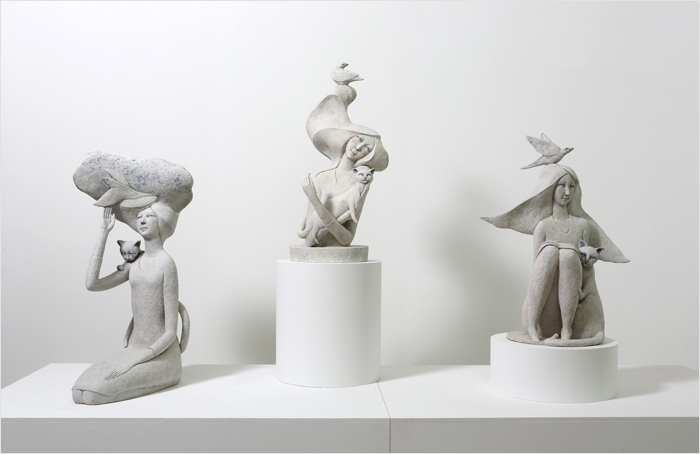
- Nari Kwon

- Introduction
Nari Kwon shows the process of changes in birds when they are influenced by the surrounding environment.
The birds displayed in the exhibition look like a group of similar birds, but each bird is expressed in unique colors. Birds flying into the sky with their wings spread on the wall are tinted in diverse colors with slight gradations in shade. As independent living creatures with their own identities, birds speak for life as it constantly changes in response to influences from the extremely varied environment.
The colors of birds, that are continually changing, reflect our lives today as we influence each other and as they establish relationships all around and undergo experiences big and small.
The viewers can see that the artist is trying to recognize animals as living creatures that are changing organically in situations and relationships, open to changes and accommodation of such changes, and have potential for new creation.
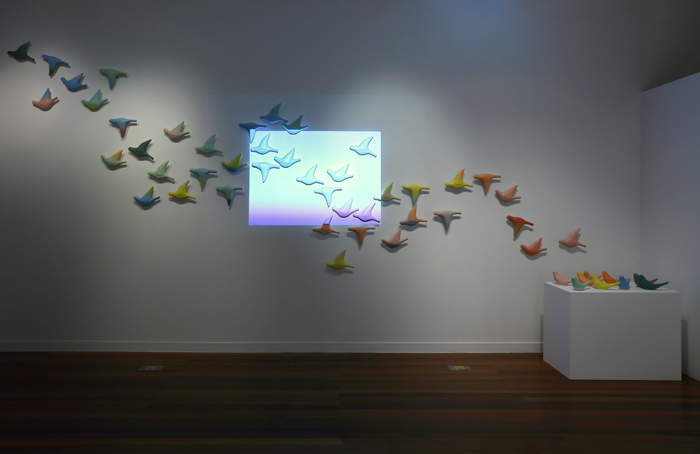
- Soonsik Kim

- Introduction
Soonsik Kim has explored the possibilities of expression of painting on ceramics.
The artist has used decorative techniques of painting in cobaltblue and overglazed designs in multiple colors used on ancient Chinese ceramics, and combined painting and sculpture using diverse materials such as wood, metal, and stone.
Various subjects depicted on the surfaces of his works, such as donkeys and birds wearing golden crowns, represent his determination to pursue desire for reality and innocence at the same time.
Clear and delightful cobalt-blue on his works symbolizes hope. The world towards which a blue horse is running with its wings flapping is an ideal land, rather than the end of life on this world. Pegasus, the winged horse, never dies even if he is dead, and is instead flying to the world of free spirit.
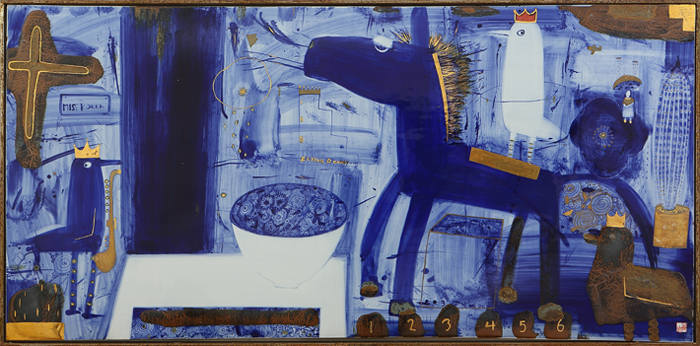
- Jaegyu Kim

- Introduction
Works by Jaegyu Kim always feature animals.
The artist compares animals with humans and looks at human society through animals.
They say “human is the lord of creation.” Being at the top of the food chain, human has developed civilization and utilized nature. It has been taken for granted that creatures other than humans exist for humans.
Animals have always been together with humans, but only humans have been masters: animals have been merely assistants. The artist intends to invite these companions in this world who have been always there for humans, witnessing human history in silence, to the center of stage. Feast is set for much appreciated friends who have healed the human psyche.
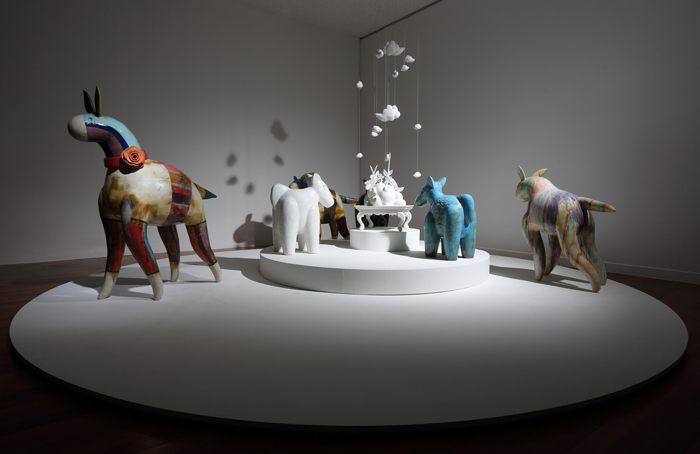
- Zonghyuk Kim

- Introduction
Zonghyuk Kim has taken care of some thirty stray cats since 2010.
He has naturally learned a great deal about their disposition and behavior and sometimes witnessed emotions and strong motherhood instincts in them just like humans. The emotions he felt while living with the cats are expressed in his art.
The widespread perception that cats are scary and symbolize the wicked is cast away, and instead warm and amiable cats playing in their unique, dynamic way are shown in his works. By decorating vivid flowers on cats, Zonghyuk Kim tries to make the viewers see something warm and beautiful.
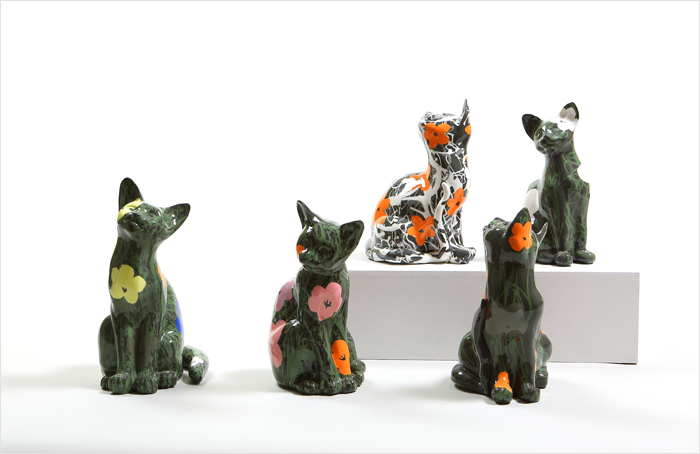
- HyunJu Roh

- Introduction
Animals as seen by Hyun-ju Roh are mighty, quiet, and peaceful. The artist feels the weighty presence of animals that live this world together with humans. She recognizes animals as creatures in an equal relationship with humans, rather than a subordinate relationship.
She has worked on visualizing animal images in her knowledge, experience, and subconsciousness as sculptural shapes. By expressing behaviors, appearances, characteristics, and movement of animals, she aspires to express a feeling of vitality inherent to animals.
Drastically deleted and subjectively focused white shapes of animals communicate dignity of life, as can be seen in angled planes perfectly cut.
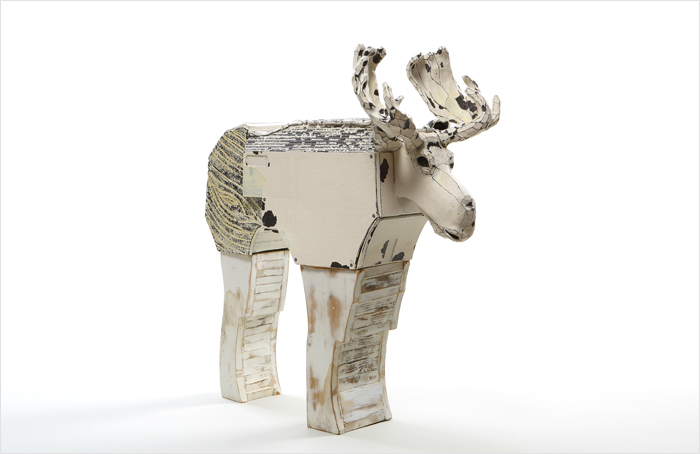
- Wookjae Maeng

- Introduction
Pigs are one of the animals with a close relationship with humans in everyday life.
The meats of pigs are important ingredients of many recipes. Pigs are also used for religious rituals. One day, Wookjae Maeng happened to see a truck full of pigs going someplace.
The pigs seemed to be on their way to abattoir after having lived in a cramped, caged environment. Then, the artist made eye contact with some of the pigs. Perhaps mistakenly, the artist thought that the pigs looked relaxed and happy.
The artist cannot forget the faces of the pigs looking outside with smiles of contentment as if they were enjoying freedom and the breeze passing by, even if only for a short time.
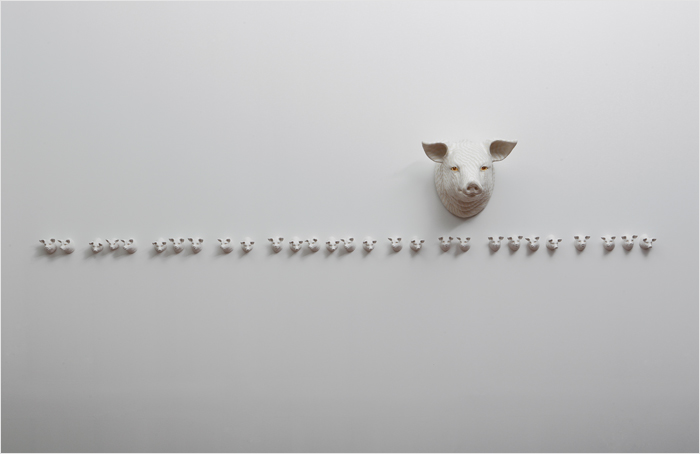
- Kohwoon Park

- Introduction
Kohwoon Park reinterprets the shapes of various animals in fairytales or myths with her own language. Most of the animals she takes as the subjects of her works are from Egyptian mythology.
To Kohwoon Park, animals in Egyptian myth are creatures that existed alongside humans and were considered as sacred. She creates shapes of such animals by combining various materials such as white porcelain, metal, and glass, and with colorful and rich emotions. With love for animals in the myths, she gives names to each of the animals to be created before starting work.
Each of her animal objects has a story of its own. Through her work, the viewer is invited to a room of mysterious stories out of familiar space.
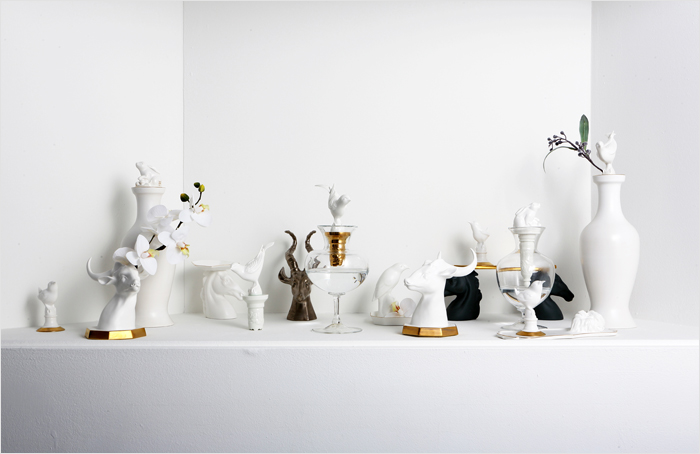
- Insoo Park

- Introduction
Insoo Park expresses his own experiences and his subjective world about memories on the past, imagination, dreams, and romance through symbolic sculpture in animal shapes. For this exhibition, Insoo Park has produced works about ‘waiting.’
The fox in The Little Prince, penguins in documentaries, and poppies and cats he raised in his childhood are gathered in the exhibition space. He focuses on eyes most when working on his animal sculptures, and he keeps even defective works.
He cannot throw them away because as he continues working on his sculptures, he gradually comes to consider them as objects with emotions. He feels something from clay, and he can feel emotions of animals he sees every day.
He sees them all like old friends with whom he can share feelings and commune with.
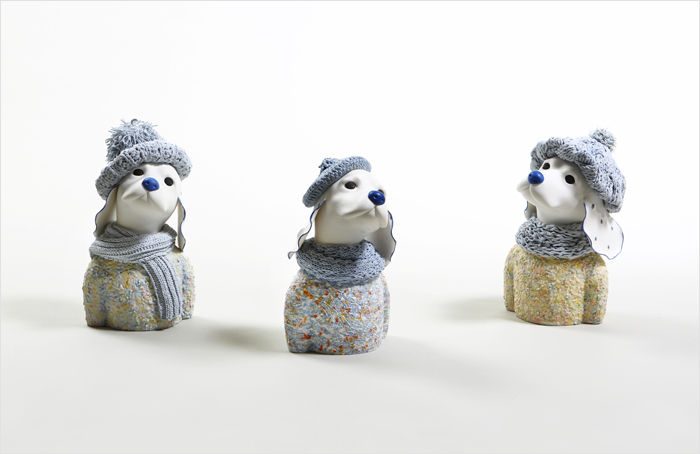
- Joonsang Park

- Introduction
Despite the fact that humans as the lords of creation are part of nature, humans are now destroying nature.
The nature that was analyzed, dismantled, and newly interpreted by human standards is depicted in the shape of a deer with machines installed. The deer is a sacred animal, and their antlers symbolize nature because they represent regeneration.
Joonsang Park presents a deer in the shape of nature juxtaposing
with the machines inside, which may seem to represent destruction or evolution. Whatever the case, the artist intends to examine the relationship between human and nature.
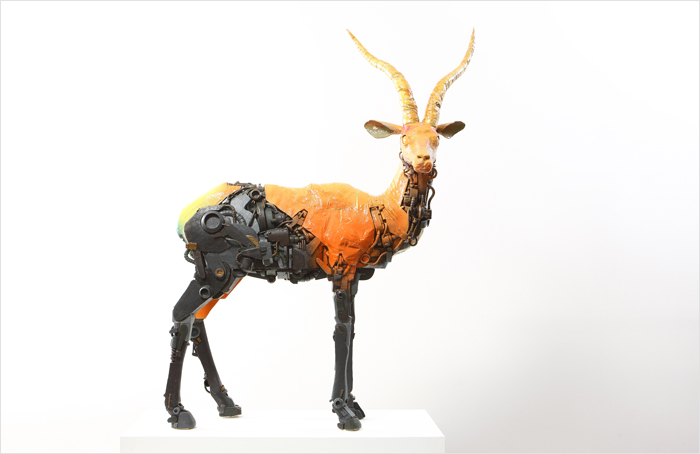
- Junhyun Park

- Introduction
Jun-hyun Park works on ceramics with the subjects of dogs. He delivers a message on restraining and control of pet dogs, which are controlled by leather leashes or forced to obey while confined in small spaces.
The anxiety of dogs standing on a narrow pedestal to obey their owners, leashed against their will is well captured in his work. While there are pet dogs that are forced to wear pretty clothes and ornaments, some animals are used as food. They have lived exclusively for the comforts and tastes of humans, but now, the artist intends to start to talk about how to live better together with them.
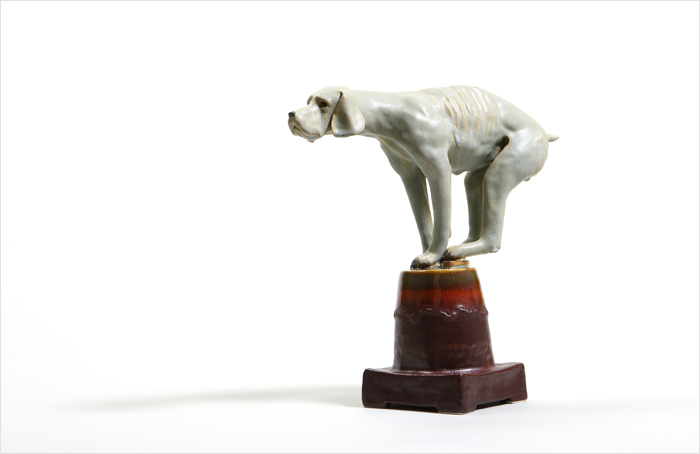
- Seungjoo Baek

- Introduction
Seungjoo Baek talks about her ties with animals, separation from them, pain, and deep sorrow through her works.
Her works feel all the more subtly emotional because they are based on her own experiences and painful realization.
Missing a dog that died after living together for sixteen years, she projects herself on a cat that hesitates to free the bird in her work. Also,
the cruel reality of animals being abused in a poor environment and abandoned, and rabbits that should be free in nature being used for experiments and sacrifices, greatly upsets the artist. How can the lives and dignity of numerous animals used and kept for humans be honored? This is the question Seungjoo Baek is posing through her work, and it is never easy to answer.
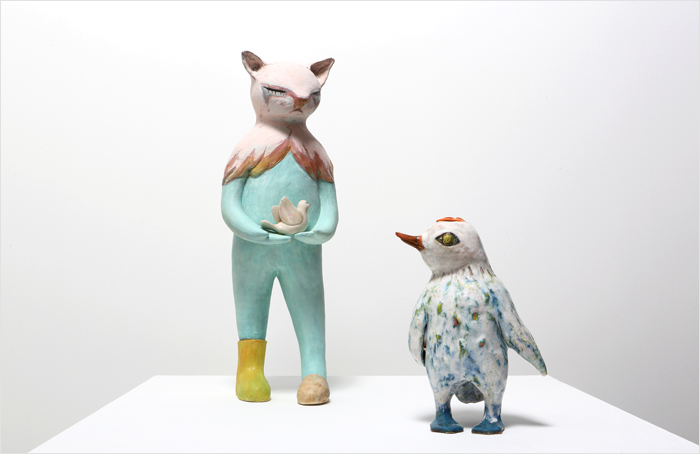
- Sangho Shin

- Introduction
Sangho Shin is an iconic ceramist who established the foundation of contemporary ceramic sculpture in Korea.
Animals in his works feel strange despite the fact that they are of shapes familiar to us. Standing in order are heads of animals, which are reminiscent of a ritual. Sometimes, they seem to be acting as guards to protect us, observing us closely. Due to its bold colors, the huge animal head from which primitive energy seems to emanate imparts the imposing feeling of casting a spell.
Sangho Shin suggests a return to primitive nature as a prescription for the dry and desolate world of modern civilization. The powerful animal sculpture with deep, insightful eyes was inspired by a totem in Africa.
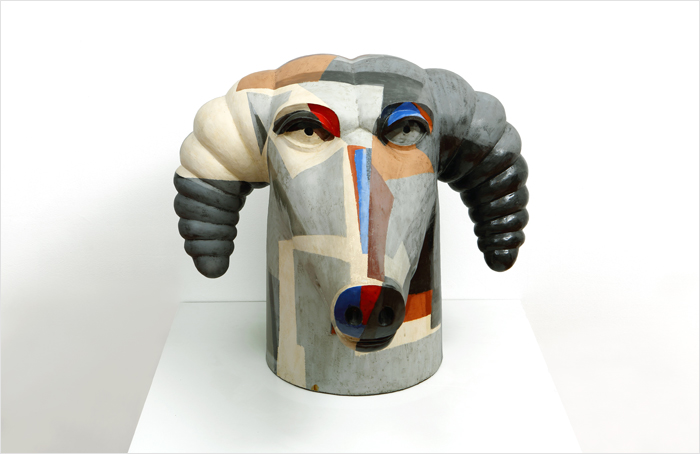
- Sooyeon Shin

- Introduction
Penguins folding their arms or chins propped up on their hands are on the ice.
They look as if they are in deep thought. Penguins standing on a small ice seem to be worrying about what to eat for dinner or deeply pondering environmental change due to global warming. Whatever the case, they look like humans.
Working on penguins as the subjects of her work, Sooyeon Shin discovered that humans and penguins share many things in common. Since then, she has naturally reflected human appearances and psychology in her penguin-shaped sculptures.
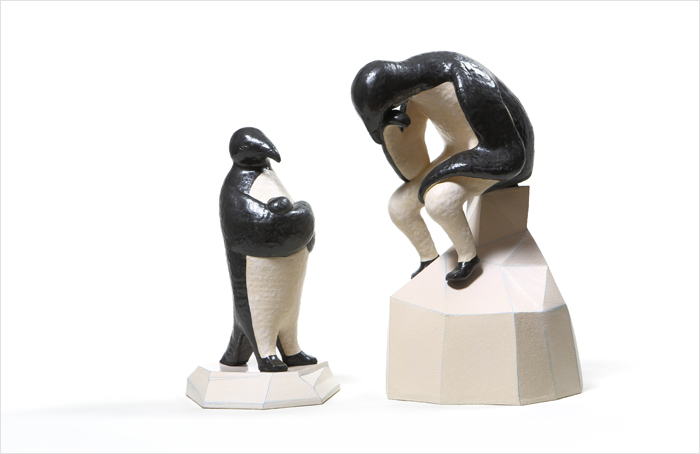
- Jonguk Yu

- Introduction
Jonguk Yu is very fond of horses.
He wrote his M.A. thesis on horses and went down to Jeju Island, where he had no family or friends but which was the homeland of horses. Since then, he has been working on horses for fourteen years. He has been in search of horses because he likes horses, and he is passionate about them. He was mesmerized by them for their dynamic features and young spirit, beautifully flowing curved lines, and symbolism of power.
He produced horses in a simplified, fairy tale shape to depict a friendly image. The planes of an adorable Korean pony-shaped sculpture are divided into geometric forms painted in red and blue, colors symbolizing Taegeuk, or yin and yang, to express structural beauty.
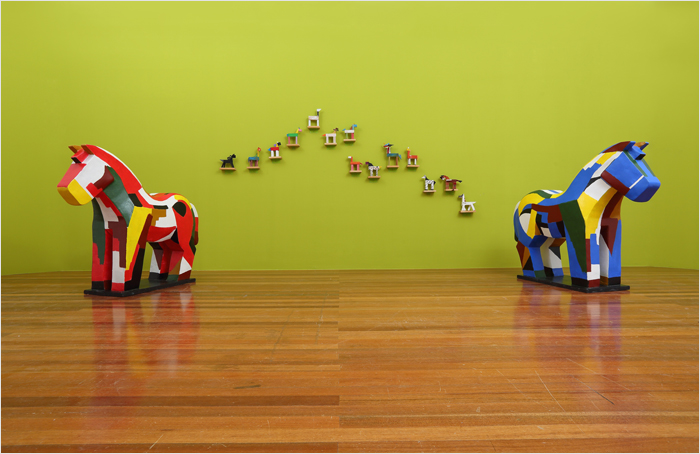
- Hojun Yoon

- Introduction
Hojun Yoon borrows images from old ceramic works well known to the public and adds his imagination to produce his work.
His work title Celadon Pomegranate-shaped Water Dropper is inspired by a celadon artifact with the same title housed at the National Museum of Korea.
He works on animals that have been closely connected with everyday life of the Koreans since long ago, such as ducks, monkeys, and rabbits. The artist analogized the symbolic meaning given to each animal by the Koreans.
Then, he created stories and expressed them through his works. He also expresses emotions he feels from animal shapes and his own ego in the shape of a child to show coexistence of human and animal.
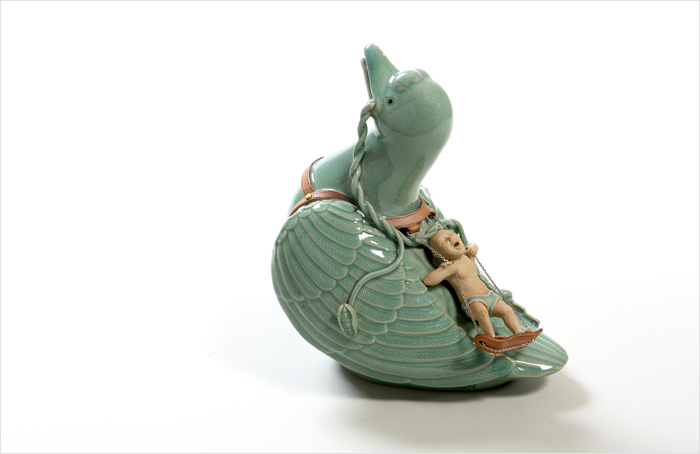
- Jaejoon Lee

- Introduction
Through his works, Jaejoon Lee projects a new perception about the relationship between human and nature that has been destroyed by modern, material civilization based on anthropocentrism.
By gluttony of human, after their fins are amputated, sharks are thrown back into the sea.
The appearance of the shark is expressed by stuffed shapes. The silhouette of the shark with unfocused eyes drawn with transparent wax is an effigy of all animals living today as well as sharks. Fish with hollow eyes are a reference to protest by living creatures suffering in the contaminated sea. This is a
representation of animals that are in danger of disappearing into extinction due to our selfish desires. and his own ego in the shape of a child to show coexistence of human and animal.
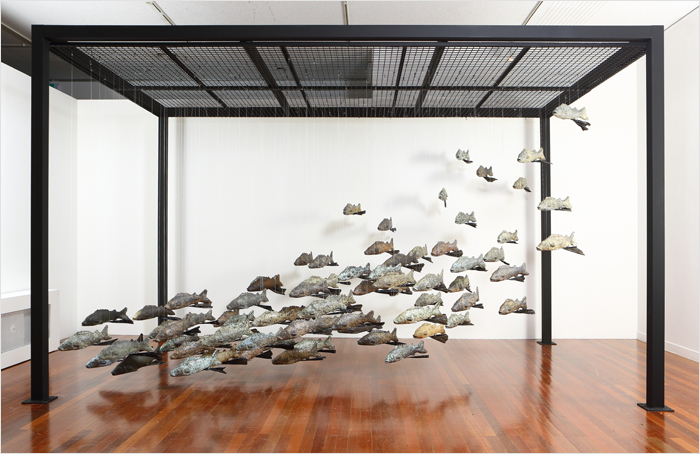
- Eungyu Jang

- Introduction
Eungyu Jang’s works of animals are somewhat slightly different from animals we know.
The wild animals were created by images accumulated in her mind. Jang’s animals are standing on small cement plot, through which Jang expresses her once innocent spirit disappearing from her inside world in the same way that nature which was once living ground is disappearing as a result of the development of cities. This work may represent desire for nature or yearning for the young spirit of childhood of the artist who grew up in a city or fear for things that are disappearing.
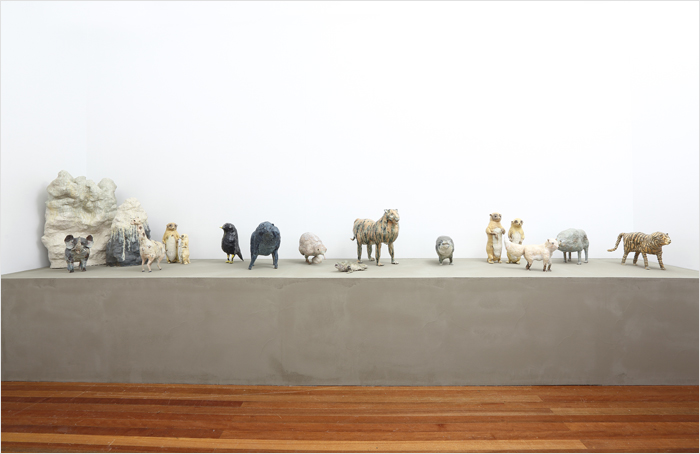
- Bosul Jun

- Introduction
Works by Bosul Jun are metaphor of innocent and strong nature of horses. Horse, the theme of her work, is a canvas that speaks for her.
Bosul Jun engraves traces of her life on her sculpture. Living creatures leave their own traces behind. Some continue to exist forever, and others disappear without leaving traces behind however hard they try to leave something.
Life leaves traces called memory. Memory travels with time. The artist is leaving traces in the shape of a horse without legs at this very moment.
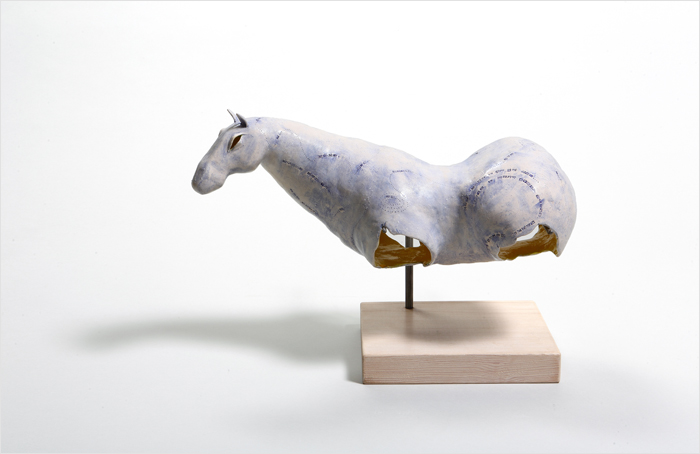
- Eunhye Jung

- Introduction
Eun-hye Jung embodies animals that are thought to be the most suffering creatures in this age with ceramic. She wants animals also to be respected as living creatures, but she expresses animals humorously rather than painfully.
Her animals show all sorts of expressions. There are pigs, cows, chickens, sheep, goats, rabbits, and horses. Some are drumming; some are carrying torches; and some are holding microphones.
In her work, animals are no longer for food or products. They are making their own voices as unique creatures.
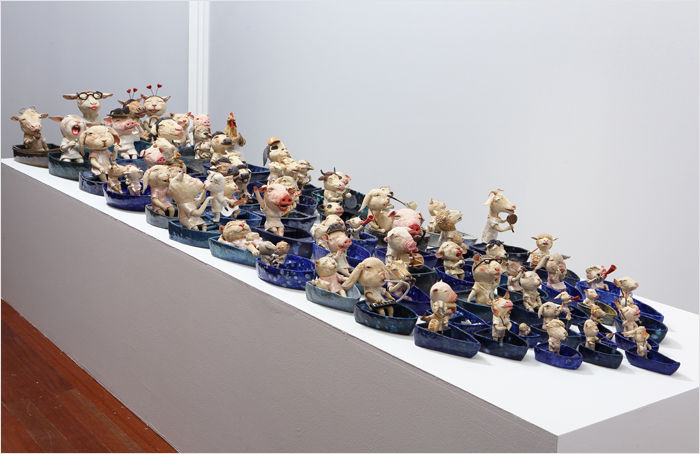
- Hoosik Joo

- Introduction
Hoosik Joo talks about the healthy relationship between human and animal as companion.
The scene of a child and a dog meeting each other without any prejudice shows that they each recognizes the other as they are. There are now 10 million pets in Korea, but the social problem of pet animals is not simple. The artist intends to start discussion beginning from paying more attention to animals and observing them. Animals produced by Joo are so detailed that they look as if they were moulded from real animals.
The detailed depiction of muscles, exquisite depiction of each claw, and vivid movement are possible because of Joo’s love for his work and for animals.
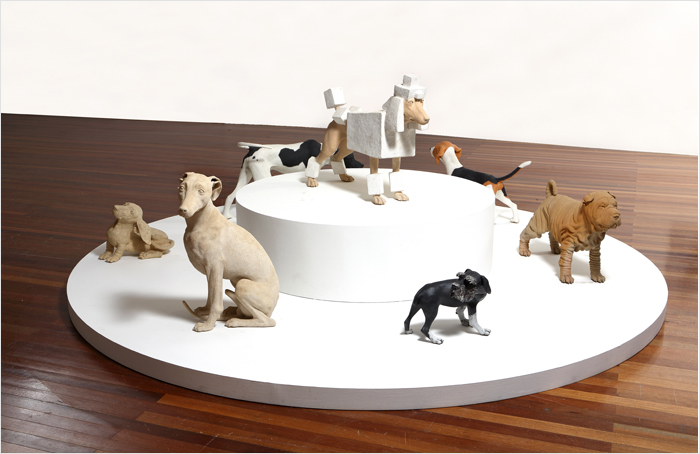
- Eunjin Choi

- Introduction
Eunjin Choi invites viewers onto a theatrical ritual stage for a moment. The altar is lined with heads of animals. The animals look peaceful as if tamed and without their inherent vitality.
Except for eagles, they are all herbivores, and the viewers feel that they all share same static image. It is the image of being tamed, honest, and daring. This kind of passive image is similar to the image of man who lives a structured and restrictive life in society. Seated at the center of stage, the viewers listen to messages from sacrificed animals on the altar and think about lost of freedom, nature degraded by human desire, and lost of humanity.
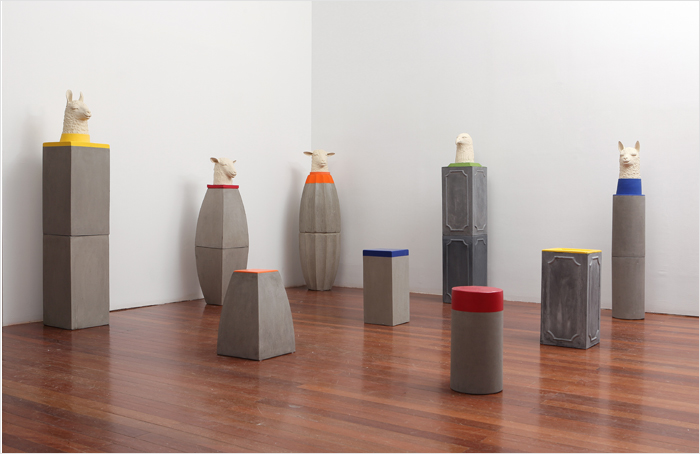
- Hojun Choi

- Introduction
Hojun Choi’s work is about stories of things he missed in the past. Shapes built from his memories are used as motifs for the designs of his work. Recalling old memories, he stimulates his emotions.
T.Q in the title of his work is the fetus name of his child. Choi intends to deliver a message of love to his child through animals. To the artist, dogs and rabbits are symbols of love he had in his childhood memory.
He reproduces his childhood memories in kidult style. Faces of the rabbits and the dogs are varied and colorful, and they are as if telling a fairy tale to us.
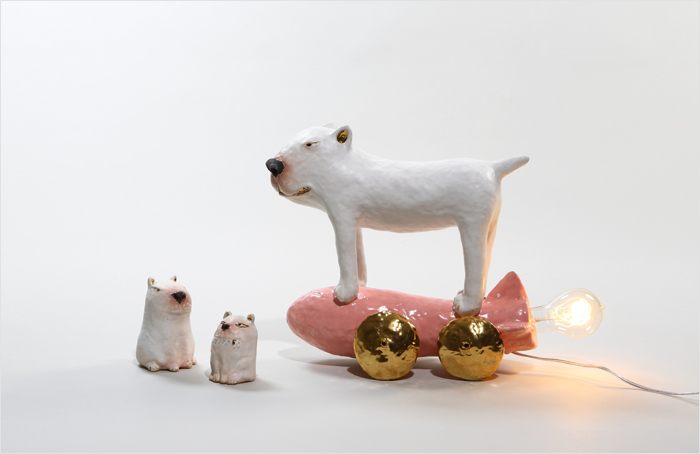
- Go Been

- Introduction
GOBEEN took the photos in this documentary when he was travelling through India, Tibet, Nepal, Pakistan, Afghanistan, and Mongolia from 1999 to 2008. Unlike typical photos in documentaries, the subjects are photographed in a subjective and emotional manner.
The animals and people in the photos make harmony with nature in the background. They well reveal the relationship of people and animals being tamed harmoniously.
This kind of harmony is felt from the homogeneous ‘similarity’ that appears among the subjects. Not only appearances, but momentary expressions and behaviors are synchronized with each other. The animals the artist encountered while travelling were like old friends who approached him, exchanged glances, said hello to him, and traveled together.
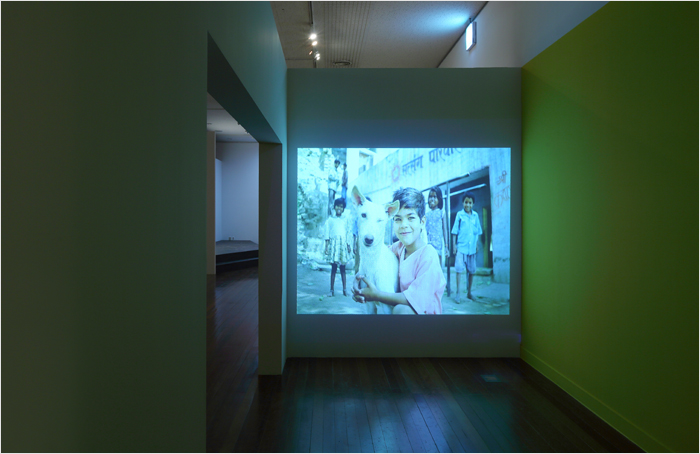
- Suyeon Kwak

- Introduction
Suyeon Kwak does paintings in traditional colors and mixes folk painting and pop art.
The primary subject of her work is the dog, because she knows through her own experience that the dog is more friendly to humans than any other animal. Animals in Kwak’s works are often personified.
Animals including dogs and cats are depicted as creatures with their own views of life without being subordinated to humans. Personified animals are a kind of avatar, the artist herself, or other people.
The artist usually uses such materials as ink, Korean paper, colored mineral pigment to depict the animals vividly and intensely. The cunning or meditative faces of animals visualize the loneliness, joy, anger, sorrow, and pleasure of human.
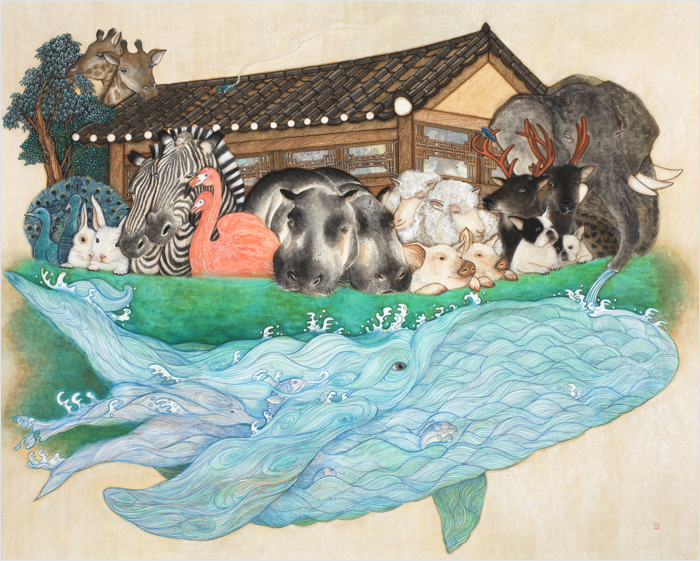
- Daeyong Byun

- Introduction
Ice cream and white bear is one of most representative works by Daeyong Byun. Through animals, the artist has produced fairy tale-like and allegorical works to figuratively express the preciousness of things disappearing today and the longing for them.
To the artist, the white bear with white and gentle sense of volume is like an image of Christmas and reminiscent of joyful memories of his childhood. The white bear is also losing his living space due to global warming and represents us trying to survive in the era of endless competition. To the white bear who left home, ice cream is food that replaces floating ice.
That is, it is food that comforts the white bear. The artist also hopes that we could be given a little comfort in this hard world.
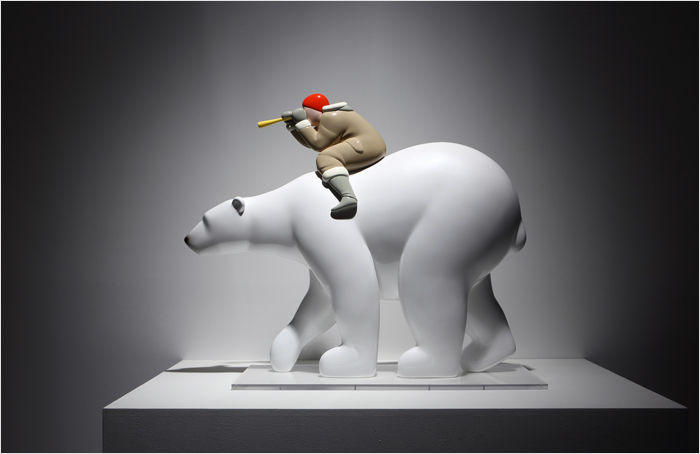
- Suknam Yun

- Introduction
Suknam Yun has focused on lives of women working with various mediums.
Learning the story of ‘Aesin’s House’ where an old lady called Aesin lives with 1,025 abandoned dogs, Suknam Yun produced 1,025 wooden dogs to lessen the pain and sorrow of abused and abandoned dogs.
One hundred of the 1,025 dogs are displayed at this exhibition. Dogs are abandoned because they are regarded as toys for humans, rather than living creatures. This work is in the same context in which she has created works on minorities and women of discriminating.
The artist intends to speak for anthropocentric thinking and the lives of the powerless creatures. This work is an act of condolence to abandoned and miserable dead animals.
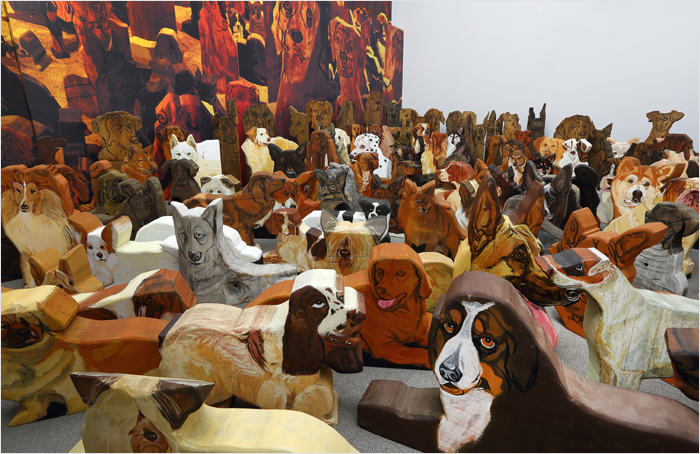
- Jeongmee Yoon

- Introduction
Jeongmee Yoon found that the people who have pet dogs look like their dogs very much, and then began to photograph the pet dogs and their owners.
She photographed scenes which reveal their relationships in such places as houses where they spend lots of time together, as well as offices and parks they frequently visit.
These scenes show not only the relationship of animals and humans but the social aspects of treating dogs as members of society or the family. Animals accompany ‘human’s life’ like another member of the family.
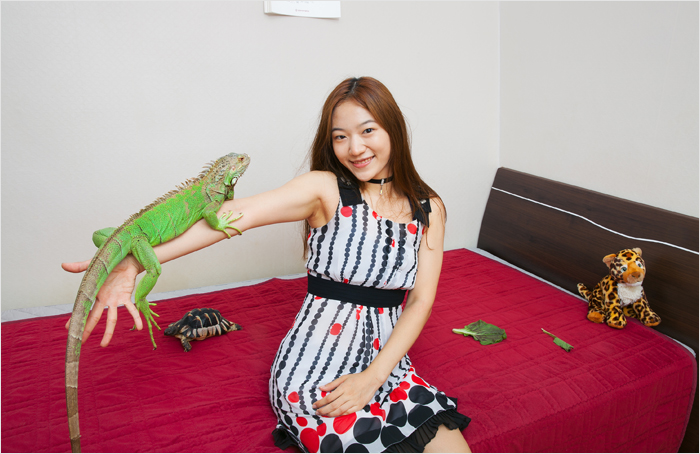
- Woojae Jeong

- Introduction
The dog in Woo-jae Jeong’s painting is ‘Kkamang,’ Jeong’s own pet dog. The artist projects the unstable image of modern people onto the image of a little girl who looks like both a child and a grown-up.
The girl is shown to be much smaller than the dog and imparts a feeling of loneliness and emptiness. The big dog in contrast with the small girl is depicted as an unwaveringly loyal creature that cures anxiety and problems confronting humans.
The lack of emotion caused by materialistic society is cured by animals. Through communion with pet dogs, the artist intends to have hope for recovering the innocence our society is losing and wishes to restore human relationships.
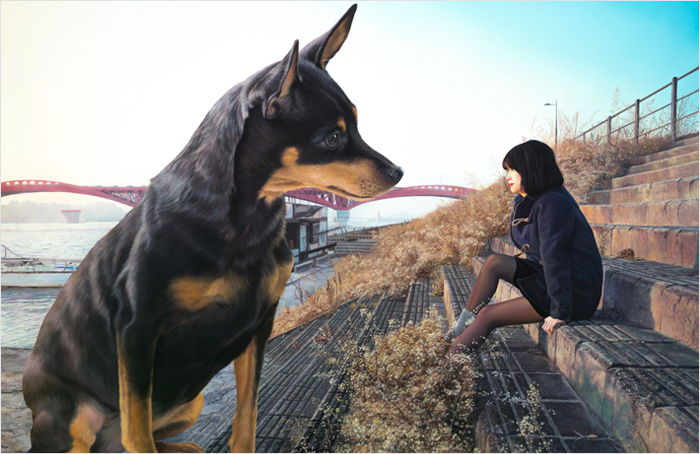
- Hyuna Cho, Sujeong Kim

- Introduction
Roadkill is a disaster for animals in human world, where roads are monopolized by human. Roadkill occurs frequently, but it is not reported in newspapers at all. A person who witnesses roadkill merely turns away with a feeling of unpleasantness.
But here, we are compelled to squarely observe the tragedy that we would otherwise turn way from. Two artists – Hyuna Cho and Sujeong Kim – deliver contradictory messages of roads stained with the death of animals becoming an illustrated animal book.
This work raises an alarm to we humans, who have become carelessly insensitive towards the death of non-human creatures. This work is an opportunity for us to look back on how seriously our sense of guilt has weakened and how the selfishness of humans has destroyed nature.
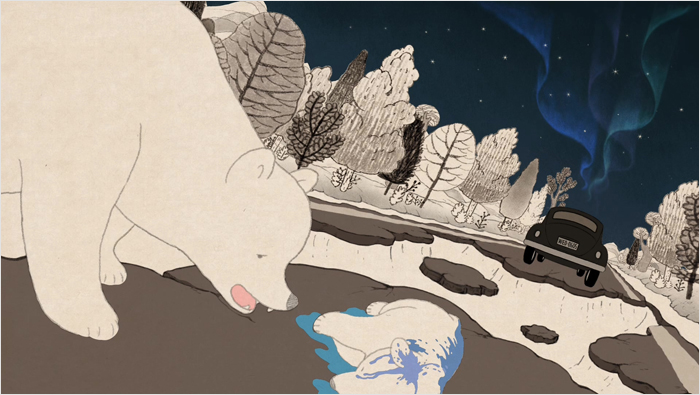
- Sungsil Hwarang

- Introduction
For this meaningful project, Sungsil Hwarang created vibrant portraits of select endangered species with the mission of making their existence known, while also alerting people of their threatened lives by expressing the IUCN red list category mark.
And they are conducting the campaign and exhibitions for endangered species by collaboration with various companies that want to protect animals.
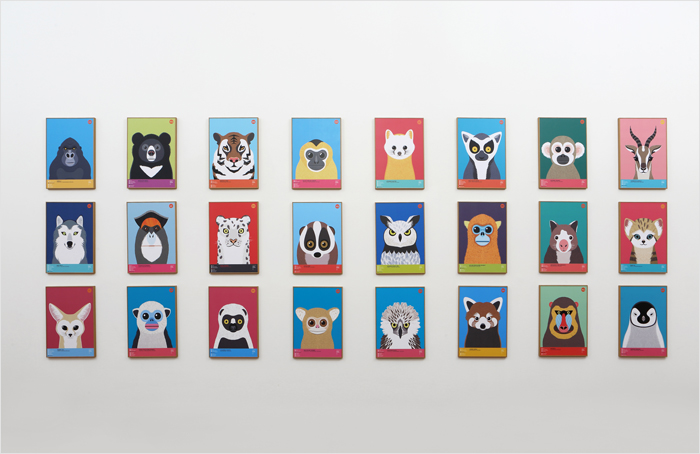
















 Ceramic Tour
Ceramic Tour

























































































